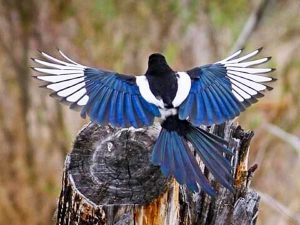Brilliant and beautiful neighbors

American Black-billed Magpie
Strutting around the yard, perched on a fencepost or swooping down from the sky, the American Black-billed Magpie makes its home in the American West – Colorado sweeping north to Alaska.
Part of the Corvidae family, the magpie is of the same group of intelligent birds to include the crow, the jay and the raven. As far as plumage goes, the magpie is considered to be one of the more striking birds, as both females and males are black and white with iridescent blue and green tail feathers. They aren’t songbirds, therefore if one is perched at the top of a tree and squawking “yak yak yak,” it’s to claim territory. They are also known to mimic the sounds of humans and other animals.
Since magpies are not strong fliers, they don’t migrate but instead find plenty to do with their mates. Highly social, as many as 50 have been seen together forming a colony. Magpies have the ability to find a food source by smell and hide their food for later, qualities that distinguish them from other birds.
Known for their aggressive hunting style and wide diet of, well, almost anything, magpies eat carrion, small mammals, insects, human garbage, and even the eggs of small, ground-nesting birds, like quail. One of their specialty “foods” is ticks they excise from unsuspecting moose, deer and elk.
If their food supply is threatened or an enemy approaches, magpies will band together and perform a “stretch display” where they flap their wings, bat their white eyelids, and spread and wave their tail feathers.
A magpie couple mates for life, and the twosome will work for 40 days to build a large nest, which is impressive for a bird family that only produces one brood. These nests are usually 12 or more feet from the ground in a deciduous tree – like an aspen or oak – near a water source and boast a roof of pointy branches for extra protection. If the couple disagrees on where to build the nest, the birds have been known to construct separate nests and decide later on the final nesting location.
Another intriguing ritual of magpies is their action and reaction to a deceased comrade. When this happens, several magpies gather for a “funeraling,” squawking for several minutes around the fallen bird. A biker from Boulder witnessed this phenomenon and saw a magpie lay a worm at the dead bird’s feet. This behavior has led ornithologists to submit that magpies are among the rare birds to feel emotion.
So even if birdwatching isn’t a hobby, look out the window at a local wonder – but remember not to leave the picnic table unguarded.
By Hollen Wheeler; courtesy photo